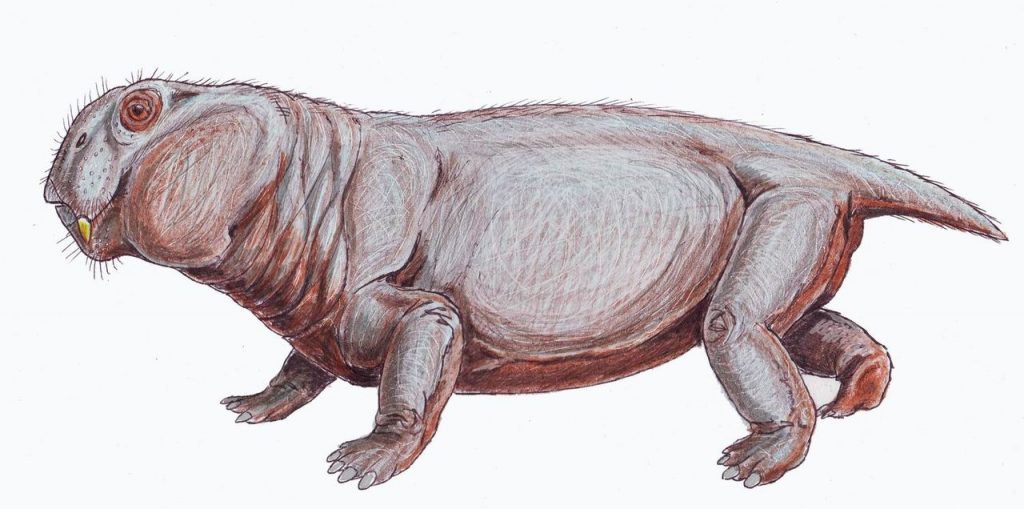Lystrosaurus, The Tenacious Burrower of the Wastelands
“This tusked survivor outlives mass extinction—meet the unstoppable Lystrosaurus!”
The Lystrosaurus is a squat, barrel-chested creature about the size of a large dog, with stout legs positioned beneath its body for endurance walking. Its most striking features are its broad, flattened beak and a pair of prominent forward-curving tusks, which protrude from its upper jaw like gardening tools. Covered in leathery, wrinkled skin and sparse bristle-like hairs, it resembles something between a pig, a turtle, and a mole.
Behavior:
Social and resilient, Lystrosauruses are almost always found in small herds, foraging, burrowing, or basking in the sun. They are not aggressive, but when threatened, they dig in—literally. A Lystrosaurus can rapidly burrow into loose earth, leaving only its tusked snout exposed. When startled, the group tends to stampede clumsily in a low, grunting wave of dust and flailing limbs.
Habitat:
Lystrosauruses thrive in arid floodplains, rocky steppe, and scrubby wastelands where hardier creatures perish. They prefer areas with loose sediment for burrowing and abundant fibrous plants and roots.
Modus Operandi:
Primarily foragers, Lystrosauruses dig shallow pits using their tusks and powerful forelimbs to uncover edible roots, fungi, and low-lying vegetation. They are capable of detecting underground water sources and prefer to remain near dried riverbeds and seasonal ponds. Their compact build and semi-sprawling gait make them deceptively fast over short distances.
Motivation:
The Lystrosaurus is driven by two things: survival and sustenance. It is a living relic—an embodiment of preternatural endurance. It does not seek conflict, but it will outlive many that do. In a fantasy world, druids and sages revere it as a symbol of resilience and rebirth, a creature that remembers what the world was before dragons.
Lystrosaurus 5e
Lystrosaurus 5e Stat Block
Lystrosaurus 3.5 Stat Block
Lystrosaurus
Small Beast, Unaligned
Armor Class 13 (natural armor)
Hit Points 13 (3d6 + 3)
Speed 30 ft., burrow 20 ft.
| STR | DEX | CON | INT | WIS | CHA |
|---|---|---|---|---|---|
| 13 (+1) | 10 (+0) | 13 (+1) | 2 (–4) | 12 (+1) | 5 (–3) |
Saving Throws Con +3
Skills Perception +3, Survival +3
Senses Darkvision 60 ft., Passive Perception 13
Languages —
Challenge 1/4 (50 XP)
Proficiency Bonus +2
Traits
Stubborn Resilience.
When the Lystrosaurus succeeds on a saving throw against being frightened, paralyzed, or stunned, it may immediately burrow 10 feet as a reaction, kicking up a cloud of dust and dirt.
Burrow Sense.
The Lystrosaurus can sense vibrations through the ground up to 30 feet away while burrowed or standing on earth or stone.
Hardy Survivor.
The Lystrosaurus has advantage on saving throws against poison and disease, and it can survive without food or water for up to 7 days.
Actions
Tusking Charge. Melee Weapon Attack: +3 to hit, reach 5 ft., one target.
Hit: 6 (2d4 + 1) piercing damage. If the Lystrosaurus moves at least 20 feet straight toward a creature before the attack, the target must succeed on a DC 11 Strength saving throw or be knocked prone.
Defensive Burrow. (Recharge 5–6)
The Lystrosaurus digs into the earth and partially covers itself. Until the start of its next turn, it gains half cover (+2 AC and Dexterity saving throws) and cannot be moved against its will. While burrowed in this way, it has advantage on Dexterity saving throws against area effects, such as a red dragon’s breath or a fireball spell.
Dinosaur, Lystrosaurus
This creature, roughly the size of a hog, roots in the soil with tusks pointing downward from its upper jaw. The middle joints of its forelimbs point outward, like a lizard, and its thick, gray hide is sparsely covered with wiry hair down its back to its stubby tail. It makes a grunting, muttering sound to itself.
Family: Dinosaurs
Medium beast, unaligned
Armor Class 14 (natural armor)
Hit Points 45 (6d8 + 18)
Speed 30 ft., burrow 5 ft.
| STR | DEX | CON | INT | WIS | CHA |
|---|---|---|---|---|---|
| 16 (+3) | 10 (+0) | 16 (+3) | 2 (-4) | 9 (-1) | 6 (-2) |
Skills Athletics +5, Perception +3 Saving Throws Constitution +5, Wisdom +1
Senses passive Perception 13
Languages –
Challenge 2 (450 XP)
Special Traits
- Headbutt. If the lystrosaurus moves at least 10 feet straight toward a creature and then hits it with a ram attack on the same turn, the target must succeed on a DC 13 Strength saving throw or be knocked prone. If the target is prone, the lystrosaurus can make one bite attack against it immediately as a bonus action.
Actions
- Ram. Melee Weapon Attack: +5 to hit, reach 5 ft., one target. Hit: 8 (2d4 + 3) bludgeoning damage.
- Bite. Melee Weapon Attack: +5 to hit, reach 5 ft., one target. Hit: 13 (3d6 + 3) piercing damage.
About
Often used as guard animals by kobolds in warmer climes, the lystrosaurus has a reputation as a sturdy and self-sufficient companion. When not working in some capacity, it rips up vegetation and masticates the day away. At night, it digs shallow burrows in the ground to sleep, which are occasionally expanded upon by its masters.
Section 15: Copyright Notice
Creature Codex. © 2018 Open Design LLC; Authors Wolfgang Baur, Dan Dillon, Richard Green, James Haeck, Chris Harris, Jeremy Hochhalter, James Introcaso, Chris Lockey, Shawn Merwin, and Jon Sawatsky.

This creature resembles a melding of pig and lizard, with a thick, barrel-like body and splayed legs. Its forelimbs look particularly strong. Its head is large but short, with high-set eyes and a hooked beak with two fangs situated directly behind it.
Originally Posted by Shade of the En World forums.
On this Thread
Lystrosaurus is a dicynodont, an herbivorous therapsid (“mammal-like reptile”).Dicynodonts are characterized by their parrot-like beaks, two tusks in the upper jaw, and barrel-shaped bodies with splayed legs. Lystrosaurus is a common, representative of the dicynodont lineage. They sleep in simple burrows during the day. Around sundown, lystrosauruses emerge from their burrows, congregating in large groups to protect their young from predators.
At dawn, the herds disperse, and individuals return to their burrows. When food becomes scarce, lystrosauruses dig for roots and ground water using their powerful forelimbs. Lystrosaurus is heavy for its size, being about 3 feet long and weighing around 200 pounds.
| Dicynodont, Lystrosaurus | |
| Medium animal | |
| Hit Dice | 5d8+15 (37 hp) |
| Initiative | +0 |
| Speed | 20 ft. (4 squares) |
| Armor Class | 14 (+4 natural), touch 10, flat-footed 14 |
| Base Attack/Grapple | +3/+5 |
| Attack | Bite +5 melee (1d6+3) |
| Full Attack | Bite +5 melee (1d6+3) |
| Space/Reach | 5 ft./5 ft. |
| Special Attacks | — |
| Special Qualities | Low-Light Vision, Scent |
| Saves | Fort +7, Ref +4, Will +2 |
| Abilities | Strength 14, Dexterity 10, Constitution 17, Intelligence 2, Wisdom 12, Charisma 4 |
| Skills | Listen +6, Spot +6, Survival +3 |
| Feats | Alertness, Endurance |
| Environment | Temperate or warm land |
| Organization | Solitary, pair, or herd (5-20) |
| Challenge Rating | 2 |
| Treasure | None |
| Alignment | Always neutral |
| Advancement | 6-8 HD (Medium) |
| Level Adjustment | – |
COMBAT
Adult lystrosauruses have few natural predators due to their size (they are large for dicynodonts), though Small predators such as the cynognathus may take young lystrosauruses. Adults ignore Small or smaller creatures unless attacked by one, retaliating by biting. If a lone lystrosaurus is threatened by a Medium or larger creature, however, it will flee back to its burrow, but will bite as a last resort.
Originally appeared as “dicynodont” in Dragon Magazine #112 (1986).

 Buy me a coffee
Buy me a coffee